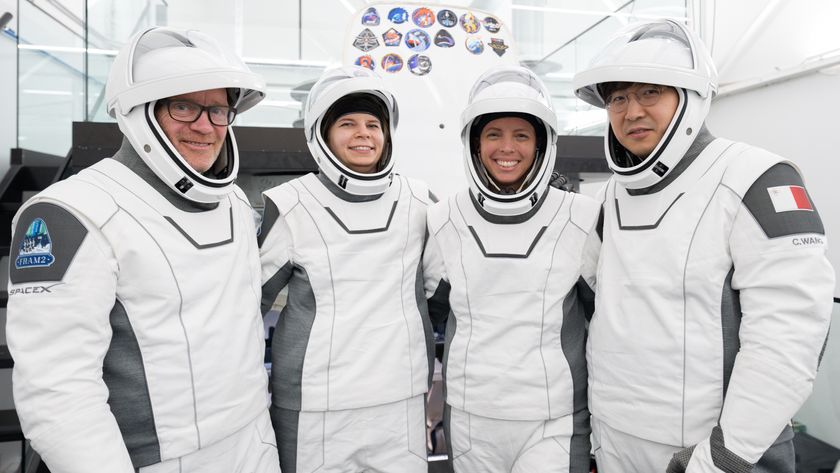Looting Asteroids' Water Will Make Launches Cheaper

There are hundreds of satellites in geostationary orbit, meaning that they orbit the Earth at roughly the same pace that our planet spins. It's a long way from where humans currently roam in space; while the International Space Station is about 250 miles above Earth, geostationary orbit is about 10 times higher — at 27,000 miles.
So how do you get one of these satellites up to this extreme altitude? The traditional methods include strapping on an extra rocket or rocket stage to kick them into high orbit, or using a lightweight electric thruster on the spacecraft that slowly pushes the satellite to the right spot. Both options are expensive, especially when you factor in the lost time as companies wait for their satellites to get up and running.
Surprisingly, an answer to this dilemma could come from an asteroid mining concept. Joel Sercel, who heads startup mining company TransAstra, and Phil Metzger, a planetary physicist at the Florida Space Institute, are among the advocates for a spacecraft that would fly back and forth, from Earth and then out to a propellant depot. This so-called "space tug" could not only provide a ride for satellites, but also extract valuable resources from asteroids.
RELATED: Asteroid Mining: Booming 21st Century Gold Rush?
Scientists and engineers recently came together at the Asteroid Science Intersections with In-Space Mine Engineering (ASIME) conference in Luxembourg to discuss the best paths to our potential asteroid mining future and how to make it more cost-effective for customers. The space tug is one of those ideas. The depot idea has actually been kicking around for a few decades, but coupling the idea with asteroid mining is relatively new.
"We agree that there is a business case," Metzger told Seeker. "You can recover the capital investment and deliver the spacecraft at a cost savings and make a profit."
While the exact locations of the spacecraft network are being worked out, this is the bare bones of the proposal: Deep in space on a mission in a few decades' time, a mining spacecraft would head out to an asteroid and extract water from it (along with other materials and precious metals). Once its mission is complete, the mining spacecraft would come back to the Earth-moon system with the water on board.
Get the Space.com Newsletter
Breaking space news, the latest updates on rocket launches, skywatching events and more!
A propellant depot somewhere near Earth would then accept the water. It would break down the water into its constituent hydrogen and oxygen gas, which are both excellent rocket fuels. And this is the genius of the plan — space launch companies don't need launch fuel into space; the fuel is already there, waiting in the depot to refuel any spacecraft that requires it.
Now comes the space tug. Once a satellite is launched, the space tug nabs the satellite and brings it up to the propellant depot to pick up a load of fuel. Then the tug zooms up to geosynchronous orbit, where it releases the satellite to do its mission.
RELATED: Mining Asteroids: Not Mankind's Silver Bullet
With such a network in place, argues Sercel, we could greatly reduce the costs associated with our current method of sending satellites to high orbits and accessing deep space. Currently, if we want to break free of Earth's orbit, the only option we have is to launch a mission with everything we need on board -- all the fuel, the electronics, and in the future astronauts. With this space tug infrastructure, we at least don't need to launch huge quantities of fuel out of Earth's gravitational well.
NASA is currently developing a large rocket called the Space Launch System that is supposed to better open up the solar system to the agency and its astronauts. SLS could be used for future missions to Mars, if NASA's plans to get there materialize as planned in the 2030s. The SLS concept is currently envisioned as an "all in one" rocket where everything, including all the fuel for the entire Mars mission's lifetime, is transmorted from Earth's surface. An obviously expensive undertaking.
Sercel argues that it's time for NASA to embrace other methods, just like it does with services to the International Space Station. NASA has a commercial cargo program with SpaceX and Orbital Sciences, and is developing a commercial crew program with SpaceX and Boeing.
"They can build the capsules in the traditional method and have the astronauts, but the NASA rocket and transportation systems are too expensive," Sercel said. He argues that by using rockets such as SpaceX's Falcon 9 — a rocket that is designed to land and be re-used again in space, although the technology is still being tested and developed — that there will be an immense cost savings in space transportation compared to government services. It will be increased "even more than that if all the propellant comes from asteroids," he added.
How much of a cost savings is hard to determine, however, because SpaceX is a private company and does not release all its figures. Earlier this year, Space News' Peter B. de Selding pointed out that SpaceX isn't the first to try to reuse space hardware. The space shuttle's main engines were designed to be re-used 55 times, but it cost far more money than what designers expected, the article said.
"In March, SpaceX President Gwynne Shotwell said the company could expect a 30 percent cost savings from reusing the first stage," de Selding wrote, then quoted the base prices of the Falcon 9 to launch a satellite to geostationary transfer orbit. Anything higher would naturally cost more.
"If this translated into a 30 percent price reduction to customers," de Selding added, "that would drop Falcon 9's advertised price to $42.8 million from today's $61.2 million."
Space mining itself is still in the early stages, with several startup companies eager to get going. However, the industry right now is mostly focused on technology development and identifying candidate asteroids. So it'll be a few years or decades before the space tug idea ever is implemented in space, if it is, indeed, found to be the best path. But it's interesting to think that a key asteroid mining infrastructure can be used to also drive down the costs of launching satellites and getting humanity into deep space.
Originally published on Discovery News.
Join our Space Forums to keep talking space on the latest missions, night sky and more! And if you have a news tip, correction or comment, let us know at: community@space.com.

Elizabeth Howell (she/her), Ph.D., was a staff writer in the spaceflight channel between 2022 and 2024 specializing in Canadian space news. She was contributing writer for Space.com for 10 years from 2012 to 2024. Elizabeth's reporting includes multiple exclusives with the White House, leading world coverage about a lost-and-found space tomato on the International Space Station, witnessing five human spaceflight launches on two continents, flying parabolic, working inside a spacesuit, and participating in a simulated Mars mission. Her latest book, "Why Am I Taller?" (ECW Press, 2022) is co-written with astronaut Dave Williams.












